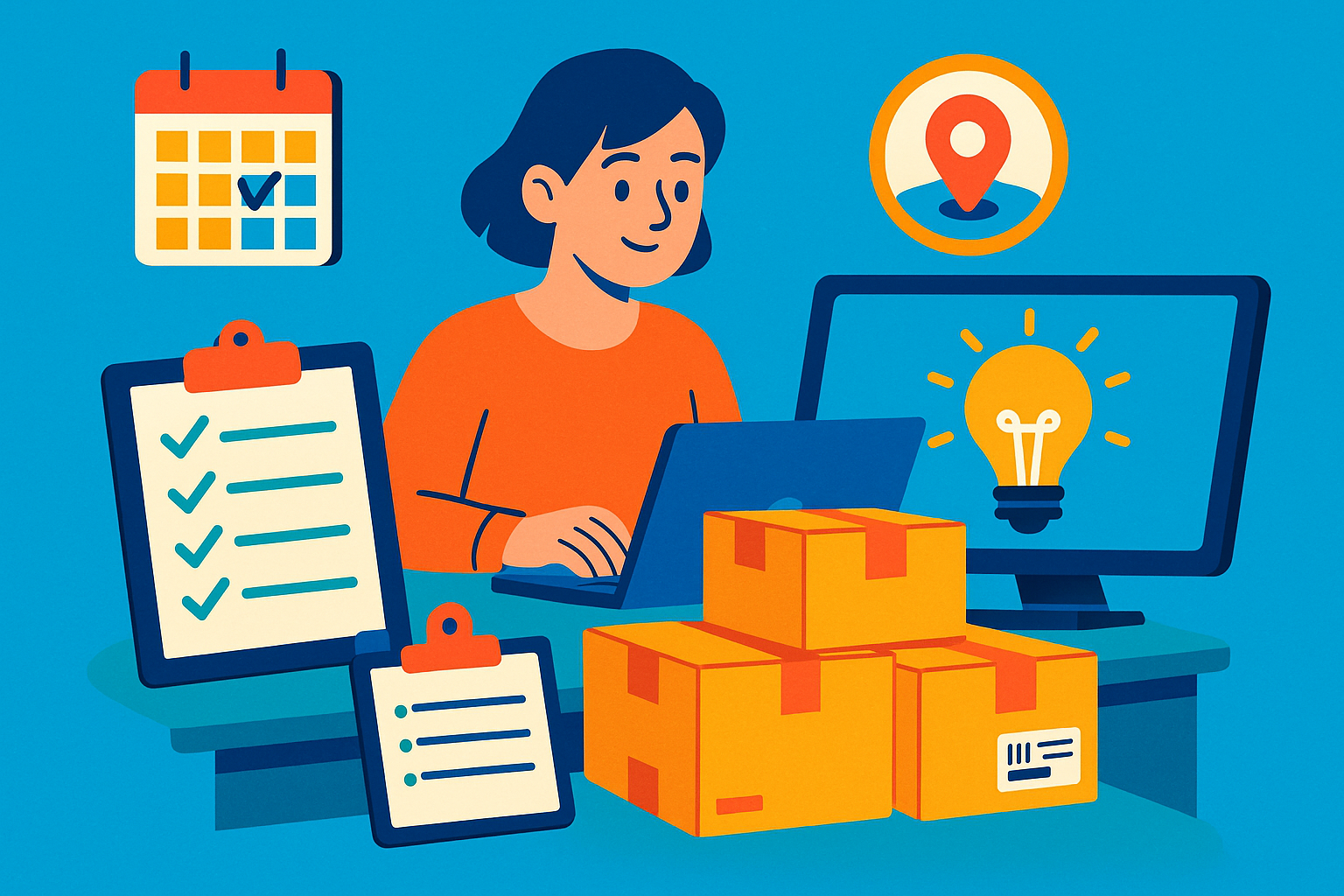Laying the Groundwork: Streamlining Your Fulfillment Strategy
Reward-based crowdfunding doesn’t end once your funding goal is reached—arguably, that’s only where the real work begins. The moment your campaign succeeds, the responsibility shifts to delivering on the promises you made to backers. Without a clear plan in place from the outset, even the most innovative projects can falter during fulfillment, resulting in frustrated supporters and tarnished reputations. Laying the groundwork for efficient reward-based crowdfunding fulfillment starts long before you receive your first pledge. By thinking strategically about the tools and processes required to transform backer support into timely, accurate rewards, you not only safeguard your project’s credibility but also set the stage for long-term growth and repeat patronage.
A successful fulfillment strategy hinges on two overarching objectives: minimizing errors and maximizing transparency. Minimizing errors requires selecting the right software to manage each phase of fulfillment, from project planning and inventory tracking to shipping and customer service. These tools should integrate seamlessly with your existing workflows—whether you’re operating as a solo creator or a small team—so that data flows smoothly from one platform to another. At the same time, maintaining transparency keeps backers informed and reassured. When supporters can track the status of their rewards at every stage, they feel respected and valued. The sense of inclusion fosters deeper loyalty and often transforms backers into advocates, amplifying your project’s reach through word-of-mouth buzz.
Before diving into specific tools, take a step back to audit your unique needs. Consider the nature of your rewards, the number of backers you expect, and any geographical complexities related to international shipping or customs. Are you distributing digital products, physical merchandise, or a mix of both? Do you need specialized packaging for fragile items? By crafting a comprehensive checklist that addresses each requirement, you create a map for selecting fulfillment solutions that align with your campaign’s scope and budget. Remember that building a scalable infrastructure now will pay dividends when your project grows or you undertake future crowdfunding campaigns. In the world of reward-based crowdfunding fulfillment, readiness isn’t a luxury—it’s the cornerstone of success.
Strategic Project Management: Choosing the Right Platforms
Once you’ve mapped out your fulfillment requirements, the next step is selecting a project management platform that can serve as the command center for every moving part. These platforms enable you to coordinate production timelines, assign tasks to team members or external partners, and monitor progress in real time. Without centralized project management software, you risk losing track of vital details—like which backer tiers have been finalized, whether suppliers have delivered critical components, or if taxes and duties have been calculated correctly. When all stakeholders have access to a shared dashboard, accountability rises and miscommunications fall drastically.
Several project management solutions have emerged as favorites among creators running reward-based crowdfunding campaigns. Some excel in visual task tracking through Kanban boards, allowing you to move individual milestones from “to do” to “completed” with a drag-and-drop interface. Others emphasize timeline views, enabling you to calendarize key dates—like product prototype approvals, packaging design deadlines, and scheduled shipping windows. Many modern tools also support integrations with third-party fulfillment services, automatically updating inventory levels or order statuses as tasks are completed. By streamlining these processes, you mitigate the risk of overpromising on delivery dates or overlooking smaller but critical action items—such as sending thank-you emails to new backers.
Before committing to a specific platform, evaluate its scalability. Your campaign might begin with a few hundred backers but could easily expand to thousands as word of mouth spreads. Ensure that your chosen tool can handle a growing number of tasks, users, and data points without slowing down or triggering prohibitive subscription costs. In addition, review the platform’s reporting and analytics capabilities. The ability to generate custom reports—detailing task completion rates, projected timelines, and resource allocation—empowers you to make informed decisions when unexpected delays arise. Finally, prioritize user-friendly interfaces that don’t demand steep learning curves. When your team can quickly onboard and adapt, you minimize the chances of procedural bottlenecks that often derail smaller campaigns.
Optimizing Logistics: Leveraging Shipping and Fulfillment Services
For physical rewards, the logistical considerations of shipping and delivery loom large. International backers introduce complexities such as varying customs regulations, additional import taxes, and longer transit times. Even domestically, shipping volume surges can create unexpected delays—especially during peak seasons like holidays or promotional events. To navigate these challenges, many reward-based crowdfunding creators turn to specialized fulfillment services that act as intermediaries between your project and shipping carriers. These third-party experts bring economies of scale, discounted shipping rates, and a deep understanding of cross-border requirements. Partnering with a reputable fulfillment house can drastically reduce your hands-on workload and give backers confidence that their rewards will arrive without undue friction.
When evaluating shipping and fulfillment solutions, consider services that offer end-to-end tracking, real-time shipping cost estimates, and automated customs documentation. Ideally, your selected partner will integrate with your project management platform or inventory system to synchronize order details automatically. This integration minimizes manual data entry—reducing the chance of mistakes like incorrect shipping addresses or mismatched order quantities. Some modern fulfillment warehouses also provide value-added services such as kitting (assembling multiple reward items into a single package), custom labeling, and quality control inspections before dispatch. These extra layers of scrutiny help ensure that each backer receives precisely what they pledged for, boosting overall satisfaction and lowering the likelihood of costly returns or re-ships.
Even if you opt to handle a portion of shipping in-house, adopting shipping software that consolidates carrier options is crucial. Many shipping applications let you compare rates from different couriers—FedEx, UPS, USPS, DHL, and regional carriers—within a unified interface. This comparative view helps you select the most cost-effective and time-efficient service for each destination. Moreover, these platforms typically offer batch label printing, which saves hours of filling out individual shipment details—especially valuable when fulfilling hundreds or thousands of orders in a compressed timeframe. By automating shipping calculations and documentation, you eliminate one of the most common stress points for reward-based crowdfunding fulfillment: the fear of underestimating postage expenses or encountering last-minute carrier restrictions.
Real-Time Inventory Monitoring: Harnessing Tracking Software
Managing inventory for reward-based crowdfunding campaigns is a delicate balancing act between ensuring you have enough stock to satisfy backers and avoiding excess that ties up capital. Without robust inventory tracking software, you may face situations where backers pledge for items that, unbeknownst to you, are already sold out or backordered. In contrast, overestimating demand can leave you with unsold units that erode profit margins and clutter storage space. Effective inventory management software provides visibility into stock levels, alerts you when supplies dip below predefined thresholds, and even integrates with your preferred e-commerce or fulfillment partner to synchronize counts automatically across channels.
Key features to look for in inventory tracking solutions include barcode scanning support, multi-warehouse management, and batch or lot tracking. Barcode scanning accelerates on-site checks, enabling you to conduct rapid cycle counts that keep your digital records aligned with physical reality. This capability is particularly vital if you’re juggling multiple storage locations—perhaps one local warehouse for domestic shipments and another regional hub dedicated to overseas orders. Batch tracking, on the other hand, becomes crucial when dealing with perishable or serialized items. For example, if certain reward tiers include limited-edition merchandise or a collectible version signifying an early-bird pledge, tracking lot numbers ensures you can identify exactly which units were shipped to which backers—simplifying any potential recall or customer inquiry.
Many contemporary inventory systems also offer demand forecasting modules. By analyzing patterns from previous campaigns or early pre-launch orders, these forecasting tools can predict how many units you’ll need at different stages of fulfillment. While forecasting isn’t an exact science—unexpected shifts in demand can still occur—it provides a data-driven starting point that informs purchase orders, manufacturing schedules, and warehouse space allocations. This insight helps you avoid scenarios where a popular reward tier sells out mere days after your campaign ends, forcing you to scramble for additional production runs or disappoint backers waiting in line. Ultimately, real-time inventory tracking is the backbone of a smooth fulfillment operation, ensuring that every reward you promised remains available when your backers are ready to receive it.
Maintaining Backer Satisfaction: Transparent Communication Tools
Even with the most sophisticated logistics and inventory systems in place, communication remains the single most critical element for ensuring a positive backer experience. When supporters feel left in the dark—wondering whether their reward is still on schedule or if there are unexpected delays—their trust can erode rapidly. Integrating transparent communication tools allows you to keep backers informed at every step of the journey, mitigating anxieties and fostering a sense of partnership. Think of your campaign page as the public face of your project and your updates as the lifeblood that keeps community enthusiasm alive. Backers want reassurance that their investment is valued and that you’re actively working to honor your commitments.
To achieve this transparency, consider incorporating a combination of email marketing platforms, project update feeds, and dedicated support channels. Email marketing platforms can automate milestone communications—triggering messages when a certain percentage of backers have been fulfilled, when prototypes pass quality checks, or when shipments leave the warehouse. By segmenting your mailing list according to reward tiers or geographic regions, you can provide more personalized updates that anticipate region-specific concerns, such as customs clearance timelines or local courier reliability. This level of granularity signals to backers that you understand the unique challenges they face based on location or pledge selection.
In addition to emails, maintain an active project update section on your crowdfunding page. Regular updates—ideally at least biweekly during the fulfillment phase—should highlight recent accomplishments, address any obstacles, and preview upcoming milestones. When you openly share challenges, such as unexpected manufacturing delays or weather-related shipping disruptions, backed by photographic evidence or short anecdotes, supporters appreciate the honesty. This candid approach prevents rumor mills and speculation from filling the void, transforming potential frustration into empathy. Finally, establish dedicated support channels—be it a dedicated email address, a messaging integration within your crowdfunding platform, or a simple helpdesk ticketing system. Rapid responses to individual inquiries, even if only to confirm that a solution is in progress, demonstrate that you value each backer’s experience. Together, these transparent communication tools form a cohesive feedback loop, nurturing backer satisfaction and minimizing the risk of negative reviews.
Automating Support: Streamlining Customer Service for Backers
As your reward-based crowdfunding campaign transitions into fulfillment mode, the volume of inquiries and support requests can spike dramatically. Common questions may revolve around checking pledge status, updating shipping addresses, or processing reward modifications. Without automation, manually addressing each query becomes unsustainable, especially if your campaign reaches thousands of backers. That’s where customer support automation tools come into play. By deploying chatbots, canned response libraries, and integrated ticketing systems, you can respond to routine questions quickly, redirect complex issues to live representatives, and track response times to ensure service-level commitments are met.
Chatbots, embedded on your campaign page or external fulfillment microsite, can answer frequently asked questions around the clock. For example, a chatbot can provide immediate guidance on how backers can update their shipping details, or it can retrieve order status by asking for a backer-specific identification number. When more nuanced issues arise—such as missing or damaged items—the chatbot can seamlessly escalate the conversation to a human agent, attaching essential context and any previously collected backer data. This hybrid model balances efficiency with personalization, minimizing frustration and preventing support tickets from slipping through the cracks.
Meanwhile, a robust ticketing system centralizes all incoming support requests, categorizes them by priority, and tracks each ticket’s lifecycle from creation to resolution. By tagging tickets with relevant labels—such as “shipping issue,” “address update,” or “reward customization”—you ensure that no inquiry remains unlabeled or unaddressed. Equally important, these ticket labels allow you to monitor trends in customer inquiries. If a sudden surge of shipping-related questions emerges in a particular region, it might indicate a logistical hiccup requiring coordination with your fulfillment partner. Identifying such patterns early helps you intervene before an issue spirals into a broader setback. Ultimately, automating support translates into faster response times, higher backer satisfaction, and more time for you to focus on the strategic aspects of your fulfillment operation.
Data-Driven Decisions: Analyzing Fulfillment Performance Metrics
Even the best-laid fulfillment plans require ongoing optimization. To refine your processes and anticipate potential bottlenecks, you need to analyze fulfillment performance metrics in real time. These key performance indicators (KPIs) shine a light on how efficiently you’re moving rewards from inventory to backers’ hands and whether backer satisfaction metrics are trending in a positive direction. Tracking these metrics isn’t merely about reporting progress; it’s about leveraging hard data to drive continuous improvement and inform future campaigns.
Begin by establishing a dashboard that combines critical data points from your project management, shipping, inventory, and customer support platforms. Core metrics to monitor include average order fulfillment time, shipping success rate (percentage of packages delivered without issues), inventory turnover rate, and backer query response time. By visualizing these metrics side by side, you can quickly identify discrepancies—such as a region where shipping success rates are significantly lower than average or a reward tier that consistently surpasses inventory thresholds. For instance, if a color-specific t-shirt SKU is repeatedly out of stock, you can adjust manufacturing orders to prioritize that variant or allocate budget to expedited production.
Equally important are qualitative performance indicators like backer satisfaction scores or net promoter scores (NPS), which capture supporters’ subjective experiences. These metrics can be surfaced through post-fulfillment surveys auto-sent via your email platform once backers confirm receipt of their rewards. Analyzing NPS trends helps you spot elements of your fulfillment operation that may require fine-tuning—perhaps packaging quality or the clarity of packaging inserts that explain product usage. Even minor adjustments, like adding a branded postcard with care instructions, can significantly boost overall satisfaction.
Finally, incorporate forecasting tools that leverage historical data to predict resource requirements and potential fulfillment challenges. For example, if you notice that backer support requests tend to spike two weeks before international shipping windows close, you can preemptively boost your customer service staffing during that period or adjust projected shipping timelines in your campaign updates. By marrying quantitative and qualitative data, you ensure that your fulfillment operation not only runs smoothly in the present but also evolves in anticipation of future demands.
The Final Stretch: Ensuring Long-Term Fulfillment Success
Congratulations—your reward-based crowdfunding campaign has transitioned from a well-funded concept to a tangible product in patrons’ hands. However, successful fulfillment isn’t simply about checking boxes and clearing warehouses; it’s about cultivating enduring trust and opening pathways for future projects. As the final packages make their way into backers’ mailboxes, consider implementing a structured post-fulfillment plan centered on gratitude, feedback, and continuous improvement.
First, express sincere appreciation to each backer. A personalized thank-you message—whether through email, a handwritten note enclosed in the shipment, or a short video message—reinforces the emotional connection established during your campaign. Handwritten notes might feel old-fashioned, but they have a profound impact in an age dominated by digital communication. Let backers know exactly how their support made a difference, emphasizing milestones achieved with their help. This doesn’t have to be lengthy; a heartfelt couple of sentences can leave a lasting impression.
Next, gather detailed feedback through a follow-up survey specifically tailored to fulfillment. Ask questions about packaging quality, shipping timeliness, and overall satisfaction with the reward itself. Frame these questions to elicit candid responses—“Was the item packaged securely and arrive in good condition?” “Did the estimated delivery date align with your experience?” “How satisfied are you with any customer support interactions you had during fulfillment?” Compiling this data helps you diagnose recurring issues and implement refinements in your next venture. By closing the feedback loop, you demonstrate that you value backers’ perspectives and are committed to ongoing excellence.
Finally, leverage post-fulfillment momentum to maintain community engagement. Invite backers to join a mailing list for future product launches, offer them early access to upcoming limited-edition runs, or provide exclusive discounts on related merchandise. By positioning your backers as a privileged inner circle, you create a pipeline for sustained support. Additionally, encourage backers to share their experiences on social media, perhaps incentivizing them to post unboxing photos or unedited first impressions. These user-generated stories not only serve as authentic testimonials for your brand but also expand the reach of your campaign’s success, attracting new followers and potential supporters.
As you wrap up fulfillment, document every lesson learned—from which shipping carriers performed best to which inventory tracking software delivered the most accurate data. Organize these insights into a living document, accessible to any team member or future collaborator. By formalizing this knowledge base, you ensure that subsequent projects benefit from the wisdom you’ve acquired. In the world of reward-based crowdfunding, one campaign’s conclusions often serve as the springboard for the next. When you treat fulfillment as a strategic, data-driven, and relationship-focused endeavor, you transform backers into lifelong advocates and pave the way for ever more ambitious endeavors.
In summary, managing reward-based crowdfunding fulfillment requires thoughtful selection of tools that address project management, logistics, inventory, communication, customer support, and performance analysis. By investing in these essential solutions and treating each stage of fulfillment as a chance to reinforce backer trust, you not only honor your current obligations but also lay the foundation for future triumphs. When backers receive their rewards on time, in excellent condition, and with a sense of personal connection, they become ambassadors who carry your brand forward—ensuring that every penny pledged was not just a transaction, but the first step in a lasting relationship.




